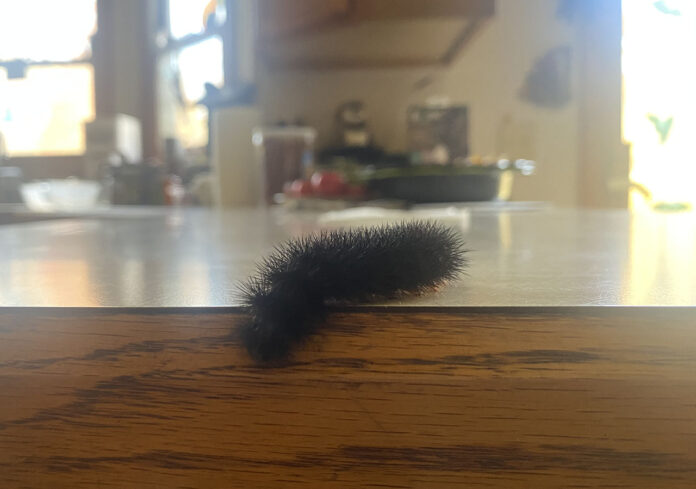It’s definitely woolly bear season. These fuzzy caterpillars are all over the place, looking for shelter to overwinter and survive until spring.
The black and brown banded Isabella tiger moth caterpillar is probably the most widely-recognized woolly bear caterpillar — the classic version if you will. However, its relative, the red-striped giant leopard moth caterpillar, is equally cute, bristly and prevalent in the fall. If you’ve ever seen one, you may have mistakenly thought you found an all-black woolly bear and were in for a terrible winter.
Both Isabella tiger moths and giant leopard moths are part of the family Erebidae. They have similar lifecycles, distributions and eating habits. As a result, caring for a red-striped woolly bear is about the same as caring for a banded woolly bear.
Life cycle
Giant leopard moths can be found in the eastern part of North America, as far north as southern Ontario and as far south as Florida. Their western border stretches from Minnesota to Texas.
Southern populations may produce two or more broods in a year, however, most populations of giant leopard moths will only produce a single brood each year. Larvae are nearly full-grown in the fall when they seem to be everywhere looking for overwintering spots. In the spring, they will wake up, eat a few more meals and develop into giant leopard moths.
Where to find red-striped woolly bears
These woolly bears can be found in lawns, fields and trees near their various food sources, but in the fall you’re most likely to discover them crossing roads, crawling along the sides of buildings or seeking shelter under plant debris. Underneath plant debris is probably the most likely place to find them if you go looking because it provides enough insulation from the weather for caterpillars and other insects to hibernate.
As mentioned above, these caterpillars appear to be completely black, but thin red stripes can be observed when they curl their bodies into a tight coil.

Taking care of a red-striped woolly bear
Like Isabella tiger moth woolly bears, red-striped woolly bears are easy to take care of. The main reason is that their diet consists of a wide variety of plants.
- Low-growing forbs and woody plants. Red-striped woolly bears will consume a variety of low-growing forbs and woody plants. These plants include papperflower, violets, dandelions, plantain, narrowleaf plantain, blackseed plantain, cherry trees, magnolias, willows, maple trees and an assortment of other plants that may be native to your region. They will also feed on leafy garden plants such as spinach, cabbage, lettuce, garden herbs and sunflowers.
They should be offered fresh food daily in a rotation that includes different food options. Many species of woolly bear caterpillars will alternate between food sources to consume many different chemicals and ensure they taste undesirable to predators.
In addition to providing your red-striped woolly bear with fresh food daily, you’ll also need to take its life cycle into consideration if you don’t want it emerging from its cocoon before spring. When it starts feeding less or stops completely, provide plant debris — leaves, bark, hollowed-out stems and twigs — and pile it in your habitat with the fresh food, so it can hibernate if it is ready. Then move your habitat to a garage, porch, patio or somewhere that’s sheltered but cooler so it can hibernate until spring.
Don’t forget to check on it frequently, especially when temperatures rise, to ensure it has access to fresh food when it emerges from hibernation. If everything goes as planned, you’ll get to release a full-grown giant leopard moth this spring!










